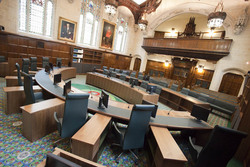The UK's new Supreme Court opened its doors on 1st October 2009 and, thanks to an innovative new broadcasting solution, it will be possible for hearings to be recorded and distributed to the media for the first time. The powerful AV broadcast system was installed by Asysco, one of Europe's most exciting audio visual systems integrators.
Egham, Surrey (PRWEB) October 9, 2009 -- The Law Lords who will preside over the highest court in the land have finally been sworn in as part of a historical constitutional change and, with help from Asysco, represents a move that will see some of the UK's highest profile court hearings televised for public viewing.

The new Supreme Court has effectively separated the legislature (Parliament) and the judiciary. It will be an independent institution that replaces the Appellate Committee of the House of Lords which, until now, has been the final Court of Appeal.
The Law Lords, who until recently heard appeals in Parliament, have now made the journey across Parliament Square and have been officially sworn in as the first Justices of the Supreme Court. Up to nine of the twelve eventual justices will sit on hearings in the two original Victorian-Gothic courtrooms and a third, modernised courtroom.
Asysco is one of Europe's highest profile audio visual systems integrators and, following a competitive tender process, was charged with the task of equipping the new Supreme Court building with an AV broadcast solution to enable the Ministry of Justice to record and distribute high quality footage from each of the courtrooms in a variety of ways. These include a live footage link to two Outside Broadcast (OB) boxes at the front of the building and direct feeds to Millbank Studios in Westminster for distribution to Sky, BBC, ITN and the Press Association.
Extensive professional AV broadcast facilities in-house
Asysco's extensive professional AV systems include high end live broadcast HD/SD TV facilities, a non-linear editing suite (NLES) and post-production facilities, camera and microphone systems and a comprehensive control system.
An HD camera arrangement and microphone and speech reinforcement system was installed into each of the court's three chambers along with dedicated preview and programme camera monitoring facilities. A main gallery was designed to house all controls, two equipment racks and a studio console with seating for three engineers, while a linked, smaller gallery space acts as a NLES with the facilities to conduct all post-production treatment in-house. A permanent exhibition area has also been created that charts the history of the judiciary system in Britain and will act as an educational resource for visitors to the Supreme Court.
All recording, editing, storage and play-out systems are supported by an AVID product suite and, in addition to recording and distribution functionality, will enable the Ministry of Justice to make recorded footage available to internal intranet users and the wider online community too.
One of our most exciting projects to date:
Asysco was appointed AV systems integrator for the project by the Ministry of Justice which commissioned the £59 million Supreme Court scheme that has been some five years in the making.
'It's been a great opportunity for Asysco to play a part in history being made,' revealed Mark Hazell, Sales Director at Asysco. 'The audio visual broadcasting scheme has called on some of the industry's most exciting recording and distribution technologies to support the groundbreaking new facilities at what will be the highest court in the land.
'We were justifiably proud to have been awarded the contract for our work by the Ministry of Justice whose Technical Consultants, PACS produced the detailed design for the tender process. By working closely with the client, consultants and the main contractor, we've been able to deliver the new audio visual systems on time, on budget and with results that the whole world will be able to follow on screen."
'The media interest in the project has helped to make this one of our most exciting to date and we're looking forward to following events that look set to make history from a very personal perspective!'
The debate on whether television cameras should be allowed to screen hearings has been vociferous and sustained, but the decision was finally made to allow cameras into the courtrooms for the first time in England and Wales since the chaotic scenes of Dr Crippen's trial in 1925. Scotland's courts have allowed televised sessions, although restrictions remain on most hearings.
Although the majority of court sessions will involve the examination of the finer technical points of law and the passing of new laws, the first hearings at the Supreme Court will be among some of the most high profile to be heard in recent years. Judgements will be made on the seizure of terrorist's assets, the long-running overdraft charging debate and the controversial decision on whether Gary McKinnon, the British hacker accused of breaking into American military computer systems should be extradited to the US.
As they say, watch this space, courtesy of Asysco's powerful audio visual broadcasting solutions.
See Also:
- Sokolove Law Enhances Resource Center to Better Serve Mesothelioma Patients and their Families
- L.A. Family Law Attorney Tamila Jensen Urges Governor to Sign Bill for Affordable Legal Service
- Schillings Win Apology and Substantial Damages for Madonna from The Mail on Sunday
- In August 2009, Roni Deutch's Law Firm Negotiates Payment Plans for Taxpayers Owing the IRS $2.8 Million
- Prominent New York Nursing Home Abuse Lawyer Urges Family Members to Watch for Signs of Bedsores
[Via Legal / Law]
- accutane with no prescription - order isotretinoin online
- cheap propecia - order generic propecia online
- viagra kaufen billig
- buy valium without prescription - buy valium
- cialis kaufen holland - viagra kaufen
No comments:
Post a Comment